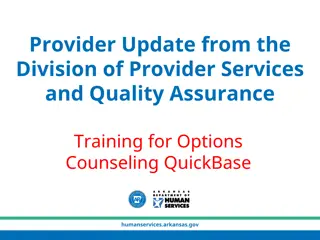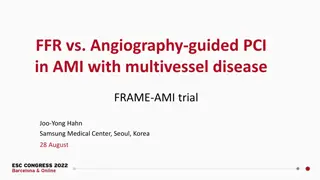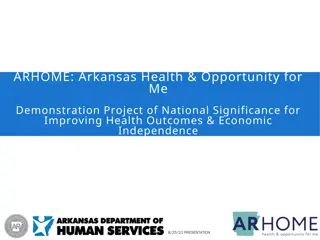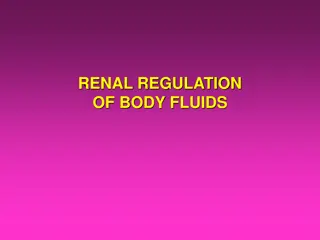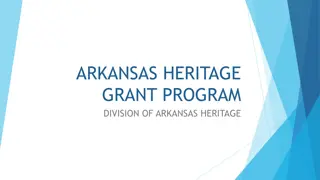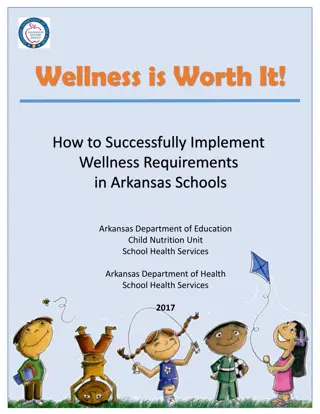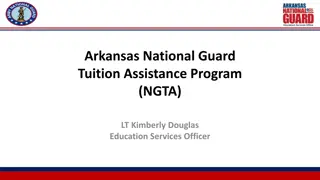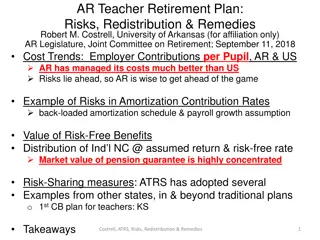Enhancing AMI Care in Arkansas: ADH's Strategic Approach
Arkansas Department of Health (ADH) is focusing on improving acute myocardial infarction (AMI) care in Arkansas due to high mortality rates. They aim to develop effective strategies, implement timely interventions, and enhance data elements for better patient outcomes. Recognizing the urgent need, ADH is working on coordinating STEMI regions, establishing a heart attack registry, and providing ongoing training for healthcare professionals to combat heart disease, the leading cause of death in the state.
Download Presentation

Please find below an Image/Link to download the presentation.
The content on the website is provided AS IS for your information and personal use only. It may not be sold, licensed, or shared on other websites without obtaining consent from the author.If you encounter any issues during the download, it is possible that the publisher has removed the file from their server.
You are allowed to download the files provided on this website for personal or commercial use, subject to the condition that they are used lawfully. All files are the property of their respective owners.
The content on the website is provided AS IS for your information and personal use only. It may not be sold, licensed, or shared on other websites without obtaining consent from the author.
E N D
Presentation Transcript
Improving AMI Care in Arkansas: ADHs Approach Whitney Ochoa, MPH, BSN, RN Christina Joshua, MPH
Bala Simon, MD, DrPH, DipABOM, DipABLM, FAAFP Deputy Chief Medical Director/State Chronic Disease Director Contact: appathurai.balamurugan@arkansas.gov David Vrudny, MPH, CPHQ Stroke/STEMI Section Chief Contact: david.vrudny@arkansas.gov The STEMI Team at ADH Whitney Ochoa, MPH, BSN, RN State STEMI Nurse Program Coordinator Contact: whitney.ochoa@arkansas.gov Christina Joshua, MPH Stroke/STEMI Epidemiologist Contact: christina.Joshua@arkansas.gov
What is an AMI? An AMI or an acute myocardial infarction can be divided into two categories: non-ST-segment elevation MI (NSTEMI) and a ST-segment elevation MI (STEMI). Unstable angina is like a NSTEMI however, cardiac biomarkers are not elevated (Mechanic, Gavin, & Grossman, 2022). Among patients suffering from an AMI, 70% of fatal events are due to coronary artery occlusion from atherosclerotic plagues, commonly referred to as atherosclerosis (Mechanic, Gavin, & Grossman, 2022). AMI still carries a VERY high mortality rate, with most deaths occurring prior to arrival to the hospital. At least 5-10% of the survivors die within the first 12 months after the MI, and close to 50% need additional hospitalization within the same year. The overall prognosis depends on the extent of muscle damage (Mechanic, Gavin, & Grossman, 2022). Good outcomes are seen in patients who either undergo early perfusion (either thrombolytic therapy within 30 minutes of arrival or PCI intervention within 90 minutes of arrival) (Mechanic, Gavin, & Grossman, 2022).
Why Get Involved? Heart disease is the leading cause of death for those living in Arkansas (CDC, 2023). Arkansas is ranked 5thamong all states for the highest heart disease mortality rate (CDC, 2021). A heart attack occurs approximately every 40 seconds (CDC, 2023). Total medical expenses for heart disease cost $228.7 billion annually in direct & indirect costs (Best Practices for Heart Disease and Stroke, 2017). Those at risk of having a heart attack include smoking, high blood pressure, high cholesterol, diabetes, obesity, family hx. of atherosclerotic cardiovascular disease, metabolic syndrome, chronic kidney disease, chronic inflammatory diseases, elevated triglycerides, physical inactivity, stress, chronic alcohol consumption, poor diet/nutrition, and even inadequate sleep (American Heart Association, n.d.). Other risk factors can include low education level, lack of income, and/or no health insurance (Delongchamp et. al, 2019). Arkansas consistently has higher ischemic heart disease rates than the US, which is believed to be due to a higher prevalence of major, modifiable risk factors (Delongchamp et. al, 2019). ADH is now involved because the residents of Arkansas are worth fighting for!
Our Plan Develop STEMI regions Conduct a hospital self-attestation survey to determine PCI availability within our state Develop The Arkansas Heart Attack Registry (AHAR) Develop the STAC Council Develop STAC Regional Representatives Perform yearly hospital program reviews for those enrolled in registry Improve on any AMI data elements that are below metric adherence (Minimum adherence is 75%) Improve timeliness of care through utilization of Pulsara Develop the Arkansas STEMI Systems of Care Best Practice and Operations Manual Provide ongoing educational training in ACS and ECG education Demonstrate a commitment to improve AMI care collectively
STEMI Regions (7) Arkansas Valley -Crawford, Franklin, Johnson, Pope, Sebastian, Logan, Scott, Yell & Polk counties Central -Conway, Faulkner, Perry, Saline, & Lonoke counties North Central -Marion, Baxter, Fulton, Searcy, Stone, Izard, Sharp, Van Buren, Cleburne, Independence, Jackson, White, & Woodruff counties Northeast -Randolph, Clay, Lawrence, Greene, Craighead, Mississippi, Poinsett, Cross, Crittenden, St. Francis, Prairie, Monroe, Lee, & Phillips counties Northwest -Benton, Carroll, Boone, Washington, Madison, & Newton counties Southeast -Grant, Jefferson, Arkansas, Cleveland, Lincoln, Desha, Bradley, Drew, Ashley, & Chicot counties Southwest Montgomery, Garland, Howard, Pike, Clark, Hot Spring, Sevier, Dallas, Little River, Hempstead, Nevada, Ouachita, Calhoun, Miller, Lafayette, Columbia, & Union counties
PCI/NPCI Self- Attestation Hospital Map
Utilize national heart attack registries to track and monitor AMI data PCI Hospitals are enrolled in the ACC CPMI registry (27 total) NPCI or Not 24/7 PCI Capable Hospitals are enrolled in AHA GWTG-CAD (46 total) ADH pays for 100% of the enrollment costs of each of these registries PCI hospitals must enter all STEMIs and eligible NSTEMIs (type 1) NPCI hospitals must enter all STEMIs 90-day data abstraction rule ADH performs an annual program review to go over yearly data Allows the state to track fallouts and develop specific QI improvements Provides award recognition Growth seen since program implementation in 2017 Our Registry Action Plan - Lytic administration has improved by 32% (GWTG-CAD) - Cardiac rehab referrals has improved by 20% (CPMI) - Adherence to discharge medications has improved by ~80% (CPMI)
An elected group of individuals that come together to reduce AMI burden Currently our council is lead by STAC chair (Dr. Adjei Interventional Cardiologist from Baptist Fort Smith), STAC cochair (Dr. Greene Interventional Cardiologist from Northwest Medical Center Springdale), and NPCI Emergency Physician (Dr. Fischer St. Bernards Five Rivers). Additional representation on the council includes organizations like the American Heart Association, the Arkansas Ambulance Association, the Arkansas Chapter of the American College of Emergency Physicians, Arkansas Department of Health, the Arkansas Emergency Nurses Association, the Arkansas Hospital Association, the Arkansas Medical Insurance Agency, the Arkansas Medical Society, the Arkansas Minority Health Commission, and even a patient advocate. Recently had a vote to add representation from your organization as well as the National Association of EMS Physicians (added as of June 2022) Meetings are conducted quarterly and have been on zoom If anyone would like to be added to these meetings, please email me at Whitney.Ochoa@arkansas.gov For STAC bylaws, please go to our ADH webpage to review at https://www.healthy.arkansas.gov/images/uploads/pdf/AR_STAC_Bylaws. pdf The STAC Council
List of STAC Council Members American Heart Association (Kristen Waller, Program Consultant of Health Care Quality) Arkansas Ambulance Association (Tim Hearn, Executive Director Fort Smith EMS) Arkansas Chapter of the American College of Emergency Physicians (Dr. Charles Corey Scott, President) Arkansas Chapter of the National Association of EMS Physicians (Dr. Lauren Bailey, Vice President) Arkansas Department of Health (Dr. Bala Simon, Deputy Chief Medical Officer/State Chronic Disease Director) Arkansas Emergency Nurses Association (Danna Bell, Nurse Educator Washington Regional) Arkansas Cardiovascular & Pulmonary Rehabilitation Association (Amanda Xaysuda, President Elect) Arkansas Foundation for Medical Care (Sarah Haney, Outreach Specialist) Arkansas Hospital Association (Cindy Crump, Quality Specialist) Arkansas Medical Insurance Agency (Dr. Schroeder, Corporate Medical Director Blue Cross Blue Shield) Arkansas Medical Society (Dr. Brandon Morshedi, Medical Director Air Evac) Arkansas Minority Health Commission (Kenya Eddings, Healthy Active Arkansas Worksite Wellness Director ADH) Chair (Dr. Adjei, Interventional Cardiologist Baptist Fort Smith) Co-Chair (Dr. Greene, Interventional Cardiologist Northwest Medical Center Springdale) Patient Advocate (Chad Mosby, Fire Chief El Dorado Fire Department) NPCI Emergency Physician (Dr. Lauren Fischer, Emergency Physician St. Bernards Five Rivers)
Each region is broken down based on various counties Each region has elected EMS, NPCI and PCI representatives Each representative serves a 3-year term These contacts are leaders within their region Each region is expected to conduct quarterly QI meetings to discuss data reviewed at the last state STAC meeting. Most meetings are typically ran by the PCI regional leader Representatives also use their quarterly meetings to continue building necessary improvement in their area and discuss any regional issues that directly impacts AMI care. Most representatives are directly involved in QI at their organizations so all are aware of expectations/needs. As of right now, 6 of the 7 regions meet regularly STAC Regional Representatives
List of STAC Regional Representatives (1 of 2) AR Valley PCI Representative: Louise Burrough (Cath Lab Manager Baptist Fort Smith) NPCI Representative: Michele Shoptaw (DON Chamber Memorial) EMS Representative: Latricia Maynard (Base Clinical Manager Survival Flight) Central PCI Representative: DeeDee Moline (Cardiac Quality Management Coordinator CHI St. Vincent Infirmary/North) NPCI Representative: Courtney Linkous (Nurse Manager CHI St. Vincent Morrilton) EMS Representative: Mack Hutchison (Clinical Manager MEMS) North Central PCI Representative: Thomas Hawkins (STEMI Manager/Standards & Education Advisor Baxter Regional) NPCI Representative: Sheila Crymes (Nurse Manager: Med Surg/OR Baptist Heber Springs) EMS Representative: Shaine Keasler (Director Survival Flight) Northeast PCI Representative: Kevin Hawley (Cardiology/Emergency/Surgical Services Outreach Director St. Bernards) NPCI Representative: Paula Lewis (Director of Special Programs [Stroke, STEMI & Trauma] St. Bernards Five Rivers) EMS Representative: John Paul JP Thielemier (North Operations Area Manager ProMed)
List of STAC Regional Representatives (2 of 2) Northwest PCI Representative: Lindsey Abney (Cardiovascular Operations/Chest Pain Coordinator Mercy Northwest) NPCI Representative: Alex Willis (ER Unit Supervisor North Arkansas Regional) EMS Representative: Tammy East (QI Captain/Hospital Liaison Central EMS) Southeast PCI Representative: Andrea Wilkins (Director of Cardiovascular Services Jefferson Regional) NPCI Representative: Cheryl Wells (ED Nurse Manager Bradley Co.) EMS Representative: Robert Collins (Assistant Service Director & Training Officer Southeast EMS) Southwest PCI Representative: Ruth Anne Milbourn (Chest Pain Coordinator National Park) NPCI Representative: Charmaine Estell (DON Baptist Hot Springs Co.) EMS Representative: Amanda Warren-Newton (President & CEO Columbia Co. Ambulance Service)
Arkansas Heart Attack Program Reviews Templates
PCI Hospitals: Overall defect free care STEMI performance composite NSTEMI performance composite FMC to ECG times Median time of FMC to device Median time of symptom onset to arrival STEMI arrived by EMS vs. self/family Median time of hospital arrival to ECG Door to lytics NPCI Transfer Times Door to balloon time Aspirin at arrival FMC to device time Early troponin measurement after NSTEMI Immediate angiography after cardiac arrest Evaluation of LVSF Cardiac rehab referral Risk score stratification for NSTEMI Discharge meds: Beta blockers, ACE-I or ARB, aspirin, high intensity statins, P2Y12 inhibitors, & aldosterone antagonists Alive at discharge NPCI Hospitals: STEMI performance composite *Overall defect free score (new in 2023) Arrival to lytics 30 mins DIDO 30 mins ECG 10 mins of arrival STEMI +ECG to Interfacility Transport 10 mins Aspirin at arrival Adult smoking cessation advice Evaluation of LVSF Early cardiac troponin measurement 6 hrs of arrival Early invasive strategy Social needs assessment *Risk score stratification for NSTEMI (only if entering NSTEMI patients) FYI: If hospital is discharging patients, then we also address all appropriate discharge medications and cardiac rehab referral from an inpatient setting. Specific Data Metrics that are Reviewed Annually *****Any deficiencies are noted & hospitals are expected to develop internal QI process to improve. *****If hospitals are non-compliant, they will get removed from registry.
Overall Defect Free Care (CPMI Metric #8134) Is referred to as an all or nothing metric Best data metric to see if perfect patient care was provided to eligible individual Consists of the percentage of patients with all eligible care opportunities met for all 14 AMI measures These 14 AMI measures include aspirin at arrival, evaluation of LVSF, reperfusion therapy (STEMI only), door to needle time, FMC to device time, aspirin at discharge, beta blocker at discharge, ACE-I or ARB at discharge, high intensity statin at discharge, cardiac rehab referral from an inpatient setting, early troponin measurement after NSTEMI, stress test in conservatively treated patients, P2Y12 inhibitor at discharge, door in door out times (STEMI only), time to primary PCI among transferred patients, and immediate angiography after cardiac arrest. Numerator is the count of patients with all care opportunities being met for which they are eligible Denominator is the total number of STEMIs and type 1 NSTEMIs
Overall Defect Free Care: Data Breakdown (Regional vs. State Averages) 100.0% US = 74.8% 77.3% 80.0% 76.0% 70.5% 68.6% 65.1% 64.7% 64.0% 62.1% 61.6% 58.5% 60.0% 56.3% 55.2% 49.1% 49.2% 45.4% 40.0% 20.0% 0.0% AR Valley Central North Central NWA NEA SWA SEA AR 2022Q3 2022Q4 Note: Errors in abstraction of 2022 Q4 data for Southeast region have been corrected, but will not populate in benchmarks due to late submission.
Cardiac Rehab Referral from an Inpatient Setting (CPMI Metric #8421) Directly impacts each hospital s overall defect free care If a hospital misses one referral, they get a 0% adherence for overall defect free care for that specific patient. Consists of the percentage of patients hospitalized with AMI who are referred to a cardiac rehab program Cardiac rehab services have been shown to help reduce morbidity and mortality in persons who have experienced a recent coronary artery disease event, but these services are still only used in about <30% of eligible patients (Randal et. al, 2018). A key component to an outpatient CR program utilization is the appropriate and timely referral of patients. In order to hit this data metric, hospitals must provide an inpatient referral but the physician should also have a note in the EMR indicating that the patient was notified about the need for the referral. This helps not only provide the necessary referrals but also helps improve patient participation. We re now doing well with providing the referrals but HOW can we help you build participation?
Cardiac Rehab Referral from an Inpatient Setting: Data Breakdown (Regional vs. State Averages) US = 85.9% 100.0% 100.0% 99.3% 96.6% 100.0% 93.7% 92.9% 91.0% 90.7% 88.9% 87.8% 88.6% 86.3% 84.6% 80.0% 60.0% 55.4% 43.3% 40.0% 20.0% 0.0% AR Valley Central North Central NWA NEA SWA SEA AR 2022Q3 2022Q4 Note: Errors in abstraction of 2022 Q4 data for Southeast region have been corrected, but will not populate in benchmarks due to late submission.
What is it? Let s Talk Pulsara https://www.pulsara.com/ Why? https://www.pulsara.com/hospitals-and-healthcare-organizations
Reported STEMI Benefits of Using Pulsara Reduces transfer times Reduces door in door out times Reduces FMC to device times Reduces door to device times Reduces length of stay Decreases time needed to active the on-call intervention team Provides a way to activate all key players at the same time Provides immediate feedback to all health care providers involved in the patient s overall care Allows EMS to feel engaged in patient s outcome Keeps all information stored in one place to help improve data abstraction issues and streamline accessibility *For more information, please review case studies published on their website from hospitals & EMS agencies in AR *These can be found here: https://www.pulsara.com/en/resources?audience=all&illness=all&type=Case+Studies
Arkansas STEMI Systems of Care: Best Practices and Operations Manual Developed and written in 2018 Was approved by our STAC council Currently being updated to version 2 Posted on our ADH webpage Has recommendations and pathways for EMS, NPCI and PCI hospitals to follow Makes decision process easy to follow For a copy of our manual, please go to: https://healthy.arkansas.gov/images/uploads/pdf/AR_STEMI_Systems_of_Care_Manual_7.2018.pdf
EMS Course: Acute Coronary Syndrome
We currently have 445 individuals enrolled from 27 different hospitals Upon successful completion of the post-test, 6 CEU s are provided Our goal is to continue to improve the confidence of providers, reduce overall intervention times, and ultimately improve patient outcomes. Anyone who wants to be enrolled in this course should email me at Whitney.Ochoa@arkansas.gov and provide me their first name, last name, email address, associated hospital, and title. Once information is received, I will reach out and enroll them. Nursing Course: 12-Lead ECG
Our Commitment to Improve AMI Care in Arkansas: Current Ideas and Future Projects (1 of 2) Improving cardiac rehab accessibility across the state to support adequate recovery from cardiac events Engage organizations to promote cardiovascular health Prevent and manage hypertension Workplace health promotion to prevent and manage heart disease Implement technology-based strategies to optimize cardiovascular care (i.e., telehealth) Increase community and clinical public health workforces (i.e., community healthcare workers) Increase lifestyle modification programs Determine ways to reduce out of pocket costs for medications Improve transition of care process post cardiac event
Our Commitment to Improve AMI Care in Arkansas: Current Ideas and Future Projects Improve clinical support available for cardiovascular patients Improve heart attack patient care Continue to fund our Arkansas Heart Attack Registry Support utilization of the Pulsara app Improve communication between PCI, NPCI, and EMS providers Improve the number of hospitals that are Chest Pain Accredited through the American College of Cardiology (PCI hospitals) Improve the number of hospitals that are Acute Heart Attack Ready Designated through the Joint Commission (NPCI hospitals) Improve Arkansas AMI per capita death rate
References Arkansas (2023). CDC. Retrieved on 5 Jul. 2023 from https://www.cdc.gov/nchs/pressroom/states/arkansas/ar.htm Best practices for heart disease and stroke: A guide to effective approaches and strategies. (2017). National Center for Chronic Disease Prevention and Health Promotion. Retrieved on 5 Jul. 2023 from https://www.cdc.gov/dhdsp/pubs/docs/Best-Practices-Guide-508.pdf Delongchamp, R. et al (2019). Differences between arkansas and the united states in prevalence of risk factors explain variations in ischemic heart disease mortality rates among pre-medicare (45-64) and medicare (65-84) age groups. European Journal of Environment and Public Health, 3(1), 1-9. doi: 10.29333/ejeph/5838 Heart disease facts (2023). CDC. Retrieved on 5 Jul. 2023 from https://www.cdc.gov/heartdisease/facts.htm Heart disease mortality by state (2021). CDC. Retrieved on 5 Jul. 2023 from https://www.cdc.gov/nchs/pressroom/ sosmap/heart_disease_mortality/heart_disease.htm Mechanic, O., Gavin, M., & Grossman, S. (Updated 2022 Aug 8). Acute myocardial infarction. STATPearls Publishing. Retrieved on 5 Jul. 2023 from https://www.ncbi.nlm.nih.gov/books/NBK459269/ Randal, J. et al (2018). 2018 ACC/AHA clinical performance and quality measures for cardiac rehabilitation: A report of the American College of Cardiology/American Heart Association Task Force on Performance Measures, 71(16), 1814-1837. doi: 10.1016/j.acc.2018/01.004 Understand your risks to prevent a heart attack (n.d.). The American Heart Association. Retrieved on 19 Jul. 2023 from https://www.heart.org/en/health-topics/health-attack/understand-your-risks-to-prevent-a-heart-attack








